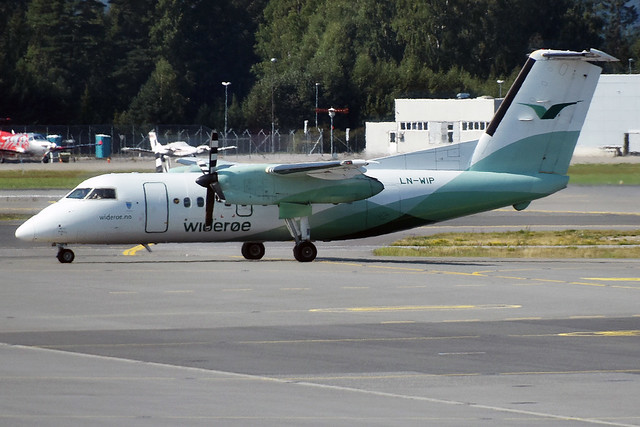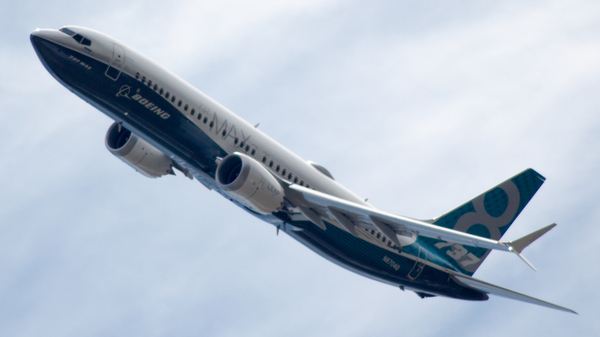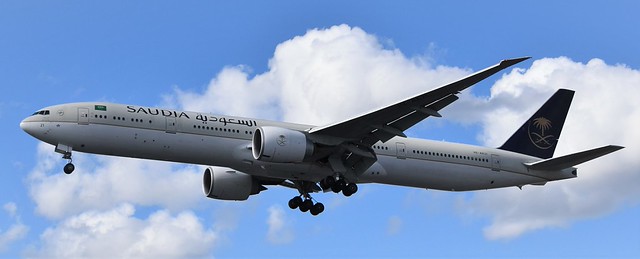Wideroe DH8A near Sorkjosen on Feb 23rd 2006, both propellers oversped, serious engine damage
Last Update: June 26, 2012 / 14:46:31 GMT/Zulu time
Incident Facts
Date of incident
Feb 23, 2006
Classification
Report
Airline
Wideroe Airlines
Flight number
WF-922
Departure
Tromso, Norway
Destination
Sorkjosen, Norway
Aircraft Registration
LN-WIE
Aircraft Type
De Havilland Dash 8 (100)
ICAO Type Designator
DH8A
Two days later maintenance determined both propellers had oversped and reported the occurrence to the Norwegian Statens Havarikommisjon (also known as Accident Investigation Board Norway AIBN).
Six years later the AIBN released their final report concluding the probable cause of the serious incident was:
In an attempt to reduce the aircraft's speed during increasing turbulence, the Commander inadvertently pulled both Power Levers past Flight Idle. This was not prevented by the built-in protection systems, and both propellers reached uncontrollably high rotation speeds. The right engine was severely damaged and control of the aircraft was partly lost. As the situation was brought under control, the crew managed to return and land safely in Tromso with one engine in operation. Widerøe has modified its aircraft to prevent recurrences.
The AIBN reported that the flight data recorder showed vertical acceleration reached -1.07G briefly during the encounter, otherwise varying between +0.2G and +2.0G. The aircraft reached a maximum bank angle of 58.4 degrees to the right and a pitch attitude of 19.9 degrees nose down, the speed of the right hand propeller accelerated from 911 rpm to more than 1500 rpm (maximum recordable speed 1500 rpm) and the left hand propeller accelerated from 916 rpm to 1483 rpm within a period of 7 seconds, during those 7 seconds the engine torque reduced from 55% to 0%. The upset began at an altitude of 8870 feet MSL, the aircraft lost 760 feet during the upset. The aircraft was doing 225 KIAS and accelerated to 243 KIAS within 10 seconds prior to propeller acceleration. 2 seconds after the left hand propeller reached 1483 rpm the propeller slowed again and returned to 914rpm, the right hand engine remained at 1500+ rpm for about 17 seconds and did not return to a normal rotating speed until being feathered 214 seconds after the onset.
Following landing it was discovered that the right hand engine had received substantial damage, for example the shaft between engine and gear box had separated and thrown fragments through the shaft housing and into the air intake.
Following the discovery both engines had oversped both engines and propellers were removed from the aircraft. The engines were sent to the engine manufacturer for further examination, the left hand propeller was examined by Wideroe's technical department and the right hand propeller was scrapped without further examination due to the loads received in flight. The engine manufacturer found the left hand engine had received no damage, the left hand propeller was also found fault free by Wideroe. In addition, both PCUs and OSGs were examined by the manufacturer and found fault free.
The engine manufacturer found the right hand engine had received following damage:
- shaft between engine and gear box had separated
- low pressure turbine shaft had separated and partially melted
- high pressure turbine shaft had separated and partially melted
- major damage to the vane rings of the second stage power turbine
- most of the second stage power turbine blades had been completely destroyed
- considerable damage between rotational and stationary parts of the engine
- significant damage to the compressor due to metal fragments passing through it
The AIBN reported that each propeller is governed by a propeller control unit (PCU), which uses hydraulic oil pressure to adjust the blade angle to maintain a rotational speed up to 1212 rpm selected by the pilots. In addition an overspeed governer (OSG) will increase the blade angle if a propeller overspeed (rpm greater than 1236 rpm) is detected, if this is not sufficient and the propeller speeds above 1308 rpm the OSG will also pneumatically reduce the engine's fuel supply. During ground operation however the PCU however does not control the propeller speed which then is the result of selected blade angle and fuel supplied to the engine, the so called "Beta Range". If the blade angle becomes negative the propeller receives energy from the oncoming airflow and thus increases rotational speed, if the propeller is adjusted at maximum angle with its leading edge straight into the oncoming airflow (feathered position) no energy is received from the airflow and little drag is being generated.
The power levers control the power generated by the turbine in all range of movement. To enter the power range for ground movement (beta range) however the power lever needs to be lifted and moved aft of the flight idle gate. As such, any movement of the power levers aft of flight idle while airborne creates the risk of the propellers overspeeding and a dramatic increase of drag to the point of losing control of the aircraft. Therefore, in order to prevent unintentional activation of the beta range, each power lever has protection and warning mechanisms, a small release trigger must be lifted (required power about 1.4kg/13.7N) by about 5mm in order to disengage a mechanical stop. In addition an intense warning sound will be triggered while airborne.
The AIBN analysed that there are similiarities to the crash of P2-MCJ, see Crash: PNG DH8A near Madang on Oct 13th 2011, both propellers oversped and also mentioned their own earlier investigation into the accident of LN-WIK at Hammerfest, see Report: Wideroe DH8A on May 1st 2005, gear collapse on landing stating that the crew had heard sounds like bird twittering in that encounter which later turned out to be the warning sound for pulling the power levers into the beta range while airborne. The AIBN referenced further occurrences with propellers inadvertently entering beta range on Fokker 50s, Embraer EMB-120s and other Dash 8s.
The AIBN reported that following first findings an interim safety recommendation was released by the AIBN to Bombardier, who had taken de Havilland over, and the Canadian Transportation Safety Board in February 2007 reading:
"The AIBN recommends that Bombardier evaluate all DHC-8 models with respect to inadvertent airborne reversing. All models that can be reversed unintentionally during pull back of Power Levers should be modified in such a manner that dangerous inadvertent airborne reversing is unlikely to happen. Until a modification is implemented operators should be informed about the hazard in an appropriate way. (Interim safety recommendation no. 06/120-9)"
This safety recommendation however was met with rejection by both Bombardier and Canada's TSB in May 2007 (editorial note: consider this statement in the light of the events on P2-MCJ in 2011, four years later, as documented so far by the preliminary report):
"Bombardier appreciates the opportunity to review and comment on the above referenced safety recommendation. We have thoroughly reviewed the existing power lever flight idle gate design and find that inadvertent airborne reversing is unlikely to occur. In our opinion, further modification to the installation is not necessary."
Wideroe took an immediate safety action by modifying the mechanical stop mechanism in accordance with a Bombardier Safety Bulletin, which necessitates the power lever to be pulled back to flight idle before the mechanical lock release trigger can be lifted.
The AIBN analysed that had power been lost from both engines as result of the power levers being pulled back aft of the flight idle gate, a successful emergency landing would have been unlikely given darkness, altitude and distance to Sorkjosen aerodrome. It was pure chance that the left hand engine did not reach the same degrees of propeller overspeed as the right hand engine did and thus escaped receiving similiar damage to the right hand engine.
The AIBN analysed further: "The incident was not caused by shortcomings in operational procedures, but by the Power Levers unintentionally pulled back so that the propellers entered Beta-Range. That this happened in spite the crew being familiar with the hazard shows that the protection and warning functions were insufficient. There is nothing to indicate that technical malfunctions caused the incident."
The AIBN went on to say that the release triggers are lifted routinely in connection with landings and the action can not be considered unusual or exceptional.
In addition "it requires more precision to grip the Power Levers without the fingers closing around the handles than it does to grip the entire mechanism. This factor is especially relevant when the aircraft is subjected to turbulence. The Accident Investigation Board can therefore understand how the Commander came to grip the entire mechanism, including the release triggers, when he suddenly had to pull back the Power Levers to Flight Idle. In this period, the g values were as low as - 1.077. ... It is therefore understandable that the release triggers may have been lifted by accident when the Commander pulled the Power Levers to Flight Idle. A force of 2 kg, which is required to pass Flight Idle, cannot be said to represent certain assurance against the Power Levers being pulled too far back. This is especially true when the aircraft is being shaken hard in turbulence."
The AIBN analysed that the safety action taken by Wideroe significantly reduced the possibility of a recurrence.
Aircraft Registration Data
Incident Facts
Date of incident
Feb 23, 2006
Classification
Report
Airline
Wideroe Airlines
Flight number
WF-922
Departure
Tromso, Norway
Destination
Sorkjosen, Norway
Aircraft Registration
LN-WIE
Aircraft Type
De Havilland Dash 8 (100)
ICAO Type Designator
DH8A
This article is published under license from Avherald.com. © of text by Avherald.com.
Article source
You can read 2 more free articles without a subscription.
Subscribe now and continue reading without any limits!
Read unlimited articles and receive our daily update briefing. Gain better insights into what is happening in commercial aviation safety.
Send tip
Support AeroInside by sending a small tip amount.
Related articles
Wideroe DH8A at Floro on Dec 4th 2013, lightning strike
A Wideroe de Havilland Dash 8-100, registration LN-WIE performing flight WF-126 from Oslo to Floro (Norway), was on approach to Floro at about 16:30L…
Wideroe DH8A at Svolvaer on Dec 22nd 2022, GPWS saves the day
A Wideroe de Havilland Dash 8-100, registration LN-WIP performing flight WF-834 from Bodo to Svolvaer (Norway), had been holding at FL090 about 13nm…
Wideroe DH8D at Bodo on Jun 26th 2025, engine shut down in flight
A Wideroe de Havilland Dash 8-400, registration LN-WDR performing flight WF-1324 from Bodo to Tromso (Norway) with 29 passengers and 4 crew, was…
Wideroe DH8D near Molde on Feb 21st 2025, turbulence causes injuries
A Wideroe de Havilland Dash 8-400, registration LN-WDP performing flight WF-516 from Bergen to Molde (Norway) with 62 people on board, was decending…
Wideroe DH8A at Bodo on Nov 22nd 2024, engine shut down in flight
A Wideroe de Havilland Dash 8-100, registration LN-WIY performing flight WF-844 from Bodo to Stokmarkness (Norway), was climbing out of Bodo's runway…
Wideroe DH8D at Trondheim on Oct 24th 2024, unsafe gear on arrival
A Wideroe de Havilland Dash 8-400, registration LN-WDR performing flight WF-1364 from Bergen to Trondheim (Norway), was on approach to Trondheim when…
Newest articles
Tway B38M enroute on Jan 10th 2026, power bank thermal runaway, 8 injuries
A Tway Air Boeing 737-8 MAX, registration HL8579 performing flight TW-634 from Sanya (China) to Cheongju (South Korea) with 32 passengers and 6 crew,…
Saudia B773 at Islamabad on Oct 14th 2024, landed on wrong runway
A Saudi Arabian Airlines Boeing 777-300, registration HZ-AK21 performing flight SV-724 from Riyadh (Saudi Arabia) to Islamabad (Pakistan) with 399…
Subscribe today
Are you researching aviation incidents? Get access to AeroInside Insights, unlimited read access and receive the daily newsletter.
Pick your plan and subscribePartner

ELITE Simulation Solutions is a leading global provider of Flight Simulation Training Devices, IFR training software as well as flight controls and related services. Find out more.
SafetyScan Pro provides streamlined access to thousands of aviation accident reports. Tailored for your safety management efforts. Book your demo today
AeroInside Blog
Popular aircraft
Airbus A320Boeing 737-800
Boeing 737-800 MAX
Popular airlines
American AirlinesUnited
Delta
Air Canada
Lufthansa
British Airways



